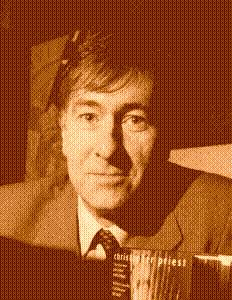Christopher McKenzie Priest
(born 1943, in Cheadle, Cheshire, England)

Christopher McKenzie Priest
(born 1943, in Cheadle, Cheshire, England)

His new novel "The Extremes"
has won the British Science Fiction Association Award for 1999. Christopher
Priest's novel "eXistenZ" (1999) involves confusion between levels
of reality, as also portrayed in novels of the American author Philip K.
Dick. The "eXistenZ" is an all-senses computer game that seems more real
than the real world and allows players to enter deeper games nested within
games, with the possibility of getting lost in the virtual maze.
"(Sir William said:) "... Time, the great mystery!""
(Christopher Priest: The Space Machine,
orig. Faber 1976,
from Futura Publ. 1977, Orbit Book p. 55)
"(Sir William said:) "Time and Space are inherently the same. I walk across this room, and I have travelled in Space a matter of a few yards... but at the same moment I have also moved through Time by a matter of a few seconds. Do you see what I am meeining?""
(Christopher Priest: The Space Machine,
orig. Faber 1976,
from Futura Publ. 1977, Orbit Book p. 56)
"(Amelia said:) "The Time Machine is attenuated, existing as it were in the Fourth Dimension. It is real, but it does not exist in the real world as we know it. It is, you must understand, travelling through Time even as we stand here.""
(Christopher Priest: The Space Machine,
orig. Faber 1976,
from Futura Publ. 1977, Orbit Book p. 62)
"He raised his body, trying
to ease his position. Lifting his head he suddenly found he was short of
breath. A hard, icy wind blew from the north, but it was thin and short
of oxygen. He lowered his head again, resting his chin on the ground. At
this level his nose could take air that would sustain him.
It was bitterly cold.
There were clouds, and borne
on the wind they skimmed a few inches above the ground like a white unbroken
sheet. They surged around his face, flowing around his nose like foam at
the bow of a ship.
His mouth was below them,
his eyes were above.
Helward looked ahead of him
through the thin, rarefied atmosphere above the clouds. He looked towards
the north.
He was at the edge of the
world; its major bulk lay before him.
He could see the whole world.
North of him the ground was
level; flat as the top of a table. But at the centre, due north of him,
the ground rose from that flatness in a perfectly symmetrical, rising and
curving concave spire. It narrowed and narrowed, reaching up, growing ever
more slender; rising so high that it was impossible to see where it ended.
He saw it in a multitude
of colours. There were broad areas of brown and yellow, patched with green.
Further north, there was a blueness: a pure, sapphire blue, bright on the
eyes. Over it all, the white of clouds in long, tenuous whorls, in brilliant
swarms, in flaky patterns.
The sun was setting. Red
to the north-east, it glowed against the impossible horizon.
The shape of it was the same.
A broad flat disk that might be an equator; at its centre and to north
and south, its poles existed as rising, concave spires.
Helward had seen the sun
so often that he no longer questioned its appearance. But now he knew;
the world too was that shape."
|
|
|
|
|
|
|